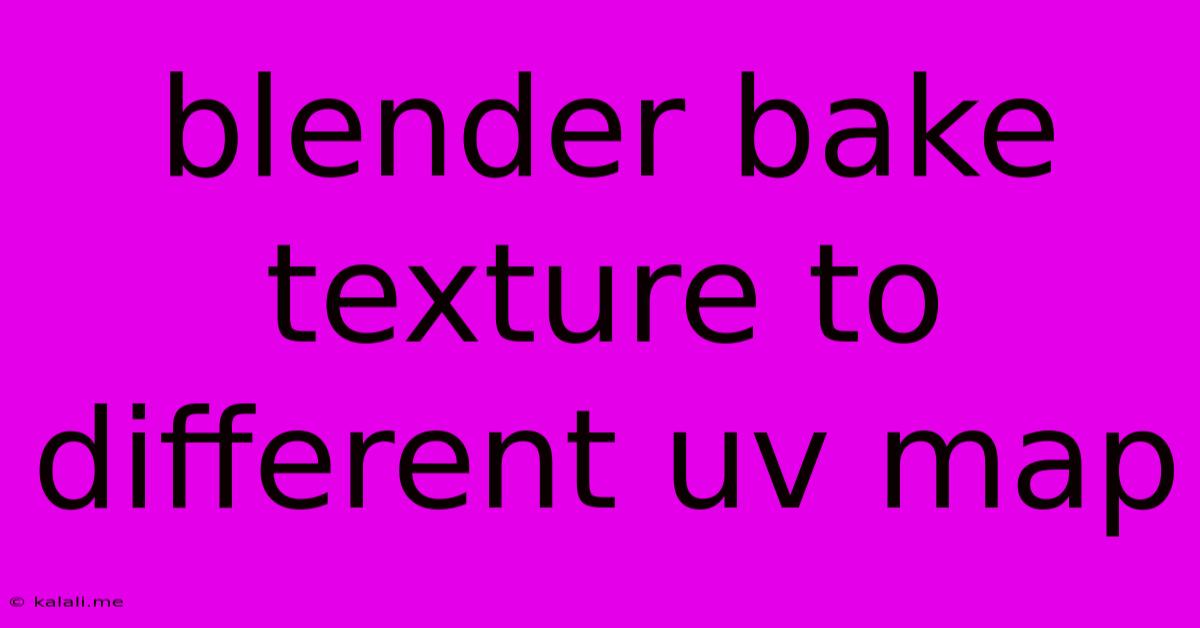Blender Bake Texture To Different Uv Map
Kalali
May 23, 2025 · 4 min read

Table of Contents
Baking Textures to Different UV Maps in Blender: A Comprehensive Guide
This article delves into the process of baking textures in Blender, specifically focusing on how to bake to different UV maps. This technique is crucial for optimizing texture memory and creating efficient game assets or complex character models. Learn how to leverage multiple UV sets for different texture types and avoid common pitfalls.
What is UV Baking and Why Use Multiple UV Maps?
UV baking is the process of transferring high-resolution information from a high-poly model (the source) to a low-poly model (the target). This information typically includes color (diffuse), normals, ambient occlusion, and other details that add realism and visual fidelity. Instead of using a single, highly detailed texture for everything, baking allows for smaller, more manageable textures targeted to specific aspects of your model.
Using multiple UV maps offers several advantages:
- Optimized Texture Memory: Different textures (diffuse, normal, AO) can be at different resolutions based on their needs. A high-resolution normal map might only require 2048x2048 pixels, while the diffuse might need 4096x4096. This prevents unnecessarily large textures and improves performance, especially in game development.
- Improved Workflow: Separating textures simplifies the texturing workflow. Instead of wrestling with one massive texture, artists can focus on individual channels, improving efficiency and reducing errors.
- Enhanced Detail: Different UV maps can be used to target specific areas of the model that require higher detail or different levels of smoothing. For example, a character model might have one UV map for the body and another for the face.
- Flexibility: Multiple UV maps allow for different texture approaches. You could bake a high-resolution normal map for one area, and use a hand-painted diffuse for another.
Steps to Bake Textures to Different UV Maps in Blender
Here's a step-by-step guide to achieve this:
-
Model Preparation: Ensure you have both your high-poly (source) and low-poly (target) meshes ready. Crucially, both meshes must share the same topology. This means the vertex count and the way vertices are connected should be consistent across both models. Discrepancies here will lead to baking artifacts. Also, create separate UV maps for each texture type you intend to bake. You can do this by adding new UV maps in the UV editor (usually "New" from the context menu). Assign the correct UV map to each object in the properties panel.
-
Material Setup: Assign the materials to both your high-poly and low-poly meshes. It’s generally a good practice to use the same material for both, but this isn't strictly necessary. Ensure your shaders are properly configured.
-
Baking Settings: In the properties panel of your model, navigate to the "Render" tab and then to the "Bake" settings. Here are some critical settings:
- Bake Type: Select the type of texture you want to bake (Diffuse, Normal, Ambient Occlusion, etc.).
- Target: Choose the appropriate low-poly mesh as your target object.
- Selected to Active: This option is important; make sure your high-poly mesh is selected and your low-poly is set as active before baking.
- UV Layer: This dropdown menu will show your available UV maps. Select the desired UV map for the chosen bake type. Repeat this step for each texture and UV map combination.
- Margin: A small margin around the islands of your UVs can prevent baking errors. Experiment to find what works best.
- Bake Mode: Choose your preferred baking mode. "Combined" is suitable for most scenarios.
- Ray Distance and Samples: Adjust these settings to control the quality of your bake. Higher values will improve quality but will also increase baking time.
-
The Baking Process: Once you've configured your settings, initiate the bake by pressing the "Bake" button. Blender will take time to complete the process, depending on the complexity of your models and the chosen settings.
-
Image Editing (Optional): After baking, you can open the generated images in an image editor like Photoshop or GIMP to further refine them.
Troubleshooting Common Issues:
- Seams and Artifacts: Check your UV unwrapping for overlapping or poorly aligned UV islands. Clean up your UV layout to minimize these issues.
- Missing Details: Adjust the bake settings (especially Ray Distance and Samples) for higher quality. Ensure proper material settings on the high-poly mesh.
- Incorrect Mapping: Double-check that you’ve selected the correct UV map for each bake type. Ensure that the correct low-poly model is selected as the target.
By following these steps, you can efficiently bake textures to different UV maps in Blender, leading to optimized, high-quality assets for your projects. Remember to experiment with settings to find the optimal balance between quality and performance for your specific needs.
Latest Posts
Latest Posts
-
How To Get Spray Paint Off Your Hands
May 23, 2025
-
Does A Simile Use Like Or As
May 23, 2025
-
Is The Last Author On The Paper The Most Important
May 23, 2025
-
How Long Can You Store Gas In A Can
May 23, 2025
-
Grab An Image Thats Outside Display
May 23, 2025
Related Post
Thank you for visiting our website which covers about Blender Bake Texture To Different Uv Map . We hope the information provided has been useful to you. Feel free to contact us if you have any questions or need further assistance. See you next time and don't miss to bookmark.